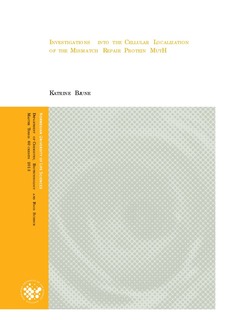| dc.description.abstract | The semiconservative replication of DNA in Escherichia coli (E. coli) gives rise to hemimetylated GATC sites behind the replication forks. Three proteins have been shown to bind to such sites; the negative regulator of chromosomal DNA replication SeqA, the mismatch repair protein MutH and Dam methyltransferase. The latter methylates the GATC sites, turning them into a non-target for the two other proteins. Earlier studies have indicated that SeqA will bind right behind the replication forks, however new studies estimate that at least 1000 bp on average separates the SeqA complex from the replisome. Studies performed in this thesis were conducted to find out if MutH binds to the hemimethylated GATC sites between the replisome and the SeqA complex. Attempts were made to tag mutH at the C-terminal end on the chromosome, but in this process the promoter of the ygdQ was deleted resulting in a cell that did not express the YgdQ protein. Little is known about the YgdQ protein except that it is an inner membrane protein. The delta ygdQ strain had a decreased growth rate, a DNA content equivalent to more than 10 E. coli cells, a round shape and an increased mass. The cells seem to struggle to divide. The phenotype of cells in this strain corresponds to cells with a deficient peptidoglycan layer, making us believe that the YdgQ protein is important for the peptidoglycan layer and the cell shape. New strains were constructed from the strain SF149 with SeqA-YFP and SSB-CFP, one with delta mutH and one with a mutD5 mutation in the epsilon subunit. We found that the mutation ratio was higher in the cells lacking proofreading compared to the strain lacking mismatch repair (MMR), which we believe came from mismatch repair saturation. The average length between SeqA and SSB foci decreased almost 50 nm when the mutH genewas removed compared to the corresponding wild type The strain with the defect proofreading subunit (mutD5 mutation) had an increased the distance between SeqA and SSB of about 50 nm. These results suggest that the MMR proteins work in a short window between the replisome and SeqA. However, we cannot say from these results if it is the lack of MutH or the lack of a functional MMR that causes the decrease of distance between the SeqA and the SSB foci. | no_NO |
